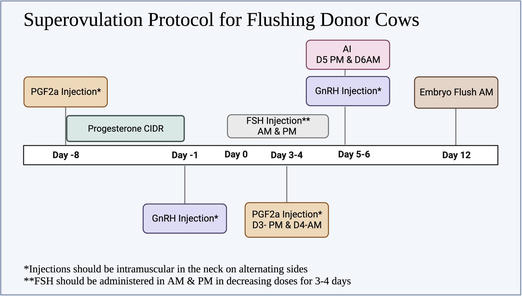
Superovulation Protocol for Conventional Flushing of Donor Cows
The most crucial component of Embryo Transfer is the generation of embryos! This can be done either through in-vitro fertilization or flushing embryos from a donor cow. Regardless, a superovulation protocol is highly recommended to increase the number of oocytes produced by the female translating to increased embryo yield per collection.
In todays post, we will discuss SUPEROVULATION PROTOCOLS FOR CONVENTIONAL FLUSHING OF DONOR COWS. Within this protocol, donor cows are given hormones to cause multiple follicles to ovulate resulting in more embryos produced.
To initiate superovulation, follicle stimulating hormone (FSH) is administered via intramuscular injection in the AM & PM over 4-5 days with decreasing doses each day. On the 3rd or 4th day, an injection of prostaglandin F2alpha (PGF2a) is given and repeated 12 hours later. Estrus should be expressed between 36-48 hours after the last injection. Donor cows should be artificially insemination based off heat detection accompanied with an injection of gonadotropin releasing hormone (GnRH) to induce ovulation. After artificial insemination, donors should be flushed 7 days later to obtain 7-day embryos for embryo transfer.
Below is an example of a superovulation protocol for donor cows. This protocol includes estrus synchronization, superovulation, artificial insemination, and embryo flushing. After flushing, these embryos can either be directly transferred into recipients (fresh transfer) or cryopreserved to be sold or used at a later date.

At the International Embryo Technology School, we offer multiple courses that cover these topics. Our most thorough course is the Combined Artificial Insemination and Comprehensive Bovine Embryo Transfer Course that will provide you with the information and training needed to set up these advanced reproductive technologies at your operation.

|
|
|